Class 12 Electrostatic Potential and Capacitance MCQ are one of the best strategies to prepare for the CBSE Class 12 Board exam. If you want to complete a grasp concept or work on one’s score, there is no method except constant practice. Students can improve their speed and accuracy by doing more MCQ on Electrostatic Potential and Capacitance Class 12 which will help them all through their board test.
Class 12 Electrostatic Potential and Capacitance MCQ
Class 12 Physics MCQ with answers are given here to chapter the Electrostatic Potential and Capacitance. These MCQs are based on the latest CBSE board syllabus and relate to the latest Class 12 Physics syllabus. By Solving these Class 12 MCQs, you will be able to analyze all of the concepts quickly in the chapter and get ready for the Class 12 Annual exam.
Learn Electrostatic Potential and Capacitance class 12 MCQs with answers pdf free download according to the latest CBSE and NCERT syllabus. Students should prepare for the examination by solving CBSE Class 12 Electrostatic Potential and Capacitance MCQ with answers given below.
Question 1. A conducting sphere of radius R is given a charge Q. The electric potential and the electric field at the centre of the sphere respectively are
(a) Zero and ![]()
(b) ![]() and Zero
and Zero
(c) ![]() and
and ![]()
(d) both are Zero
Answer
A
Question 2. A bullet of mass 2 g is having a charge of 2 μC. Through what potential difference must it be accelerated, starting from rest, to acquire a speed of 10 m/s ?
(a) 5 kV
(b) 50 kV
(c) 5 V
(d) 50 V
Answer
B
Question 3. Charge q2 is at the centre of a circular path with radius r. Work done in carrying charge q1, once around this equipotential path, would be
(a) ![]()
(b) ![]()
(c) Zero
(d) Infinite
Answer
B
Question 4. Four electric charges +q,+q, –q and –q are placed at the corners of a square of side 2L (see figure). The electric potential at point A, midway between the two charges +q and +q, is
(a) ![]()
(b)![]()
(c)![]()
(d) Zero

Answer
A
Question 5. Two charges q1 and q2 are placed 30 cm apart, as shown in the figure. A third charge q3 is moved along the arc of a circle of radius 40 cm from C to D. The change in the potential energy of the system is ![]() k, where k is
k, where k is
(a) 8q1
(b) 6q1
(c) 8q2
(d) 6q2
Answer
C
Question 6. If potential (in volts) in a region is expressed as V(x, y, z) = 6xy – y + 2yz, the electric field (in N/C) at point (1, 1, 0) is
(a) ![]()
(b) ![]()
(c) ![]()
(d) ![]()
Answer
D
Question 7. Two identical metal plates, separated by a distance d form a parallel-plate capacitor. A metal sheet of thickness d/2 is inserted between the plates. The ratio of the capacitance after the insertion of the sheet to that before insertion is
(a) 2 :1
(b) 2 : 1
(c) 1 : 1
(d) 1 : 2
Answer
B
Question 8. Four metallic plates each with a surface area of one side A, are placed at a distance d from each other. The two outer plates are connected to one point A and the two other inner plates to another point B as shown in the figure. Then the capacitance of the system is
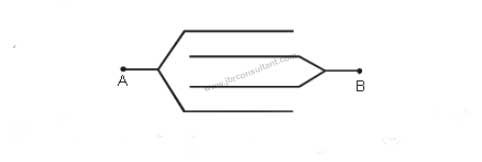
(a) ![]()
(b) ![]()
(c) ![]()
(d) ![]()
Answer
B
Question 9. In brining an electron towards another electron, the electrostatic potential energy of the system
(a) increases
(b) decreases
(c) remains unchanged
(d) becomes zero
Answer
A
Question 10. On moving a charge of 20 C by 2 cm, 2 J of work is done. Then the potential difference between the points is
(a) 0.1 V
(b) 8 V
(c) 2 V
(d) 0.5 V
Answer
A
Question 11. A positively charged particle is released from rest in an uniform electric field. The electric potential energy of the charge
(a) remains a constant because the electric field is uniform.
(b) increases because the charge moves along the electric field.
(c) decreases because the charge moves along the electric field.
(d) decreases because the charge moves opposite to the electric field.
Answer
C
Question 12. Electric potential of earth is taken to be zero, because earth is a good
(a) insulator
(b) conductor
(c) semi-conductor
(d) dielectric
Answer
B
Question. 13 Two spherical conductors A and B of radii a and b (b>a) are placed concentrically in air. The two are connected by a copper wire as shown in figure. Then the equivalent capacitance of the system is

(a) ![]()
(b) ![]()
(c) ![]()
(d) ![]()
Answer
C
Question 14. n identical capacitors joined in parallel are charged to a common potential V. The battery is disconnected. Now, the capacitors are separated and joined in series. For the new combination:
(a) energy and potential difference both will remain unchanged
(b) energy will remain same, potential difference will become nV
(c) energy and potential both will become n times
(d) energy will become n times, potential difference will remain V.
Answer
B
Question 15. A capacitor C1 is charged to a potential difference V. The charging battery is then removed and the capacitor is connected to an uncharged capacitor C2. The potential difference across the combination is
(a)![]()
(b)![]()
(c)![]()
(d)![]()
Answer
A
Question 16. In a parallel plate capacitor, the distance between the plates is d and potential difference across plates is V. Energy stored per unit volume between the plates of capacitor is
(a)![]()
(b)![]()
(c)![]()
(d)![]()
Answer
C
Question 17. Some charge is being given to a conductor. Then, its potential
(a) is maximum at surface.
(b) is maximum at centre.
(c) remains the same throughout the conductor.
(d) is maximum somewhere between surface and centre.
Answer
C
Question 18. A 4 mF capacitor, a resistance of 2.5 MW is in series with 12V battery. Find the time after which the potential difference across the capacitor is 3 times the potential diference across the resistor. [Given In (b) = 0.693]
(a) 13.86 s
(b) 6.93 s
(c) 7 s
(d) 14 s
Answer
A
Question 19. The ratio of charge to potential of a body is known as
(a) capacitance
(b) inductance
(c) conductance
(d) resistance
Answer
A
Question 20. Two identical conducting balls having positive charges q1 and q2 are separated by a distance r.If they are made to touch each other and then separated to the same distance, the force between them will be
(a) less than before
(b) same as before
(c) more than before
(d) zero
Answer
C
Question 21. If a capacitor 900 μF is charged to 100 V and its total energy is transferred to a capacitor of capacitance 100 μF then its potential is
(a) 200 V
(b) 30 V
(c) 300 V
(d) 400 V
Answer
C
Question 22. A one microfarad capacitor of a TV is subjected to 4000 V potential difference. The energy stored in capacitor is
(a) 8 J
(b) 16 J
(c) 4 × 10–3 J
(d) 2 × 10–3 J
Answer
A
Question 23. What is the effective capacitance between points X and Y?
(a) 24 μF
(b) 18 μF
(c) 12 μF
(d) 6 μF
Answer
D
Question 24. Equipotential surfaces
(a) are closer in regions of large electric fields compared to regions of lower electric fields.
(b) will be more crowded near sharp edges of a conductor.
(c) will be more crowded near regions of large charge densities.
(d) will always be equally spaced
Answer
A
Question 25. A positively charged particle is released from rest in an uniform electric field. The electric potential energy of the charge
(a) remains a constant because the electric field is uniform
(b) increases because the charge moves along the electric field
(c) decreases because the charge moves along the electric field
(d) decreases because the charge moves opposite to the electric field
Answer
C
Whoever needs to take the CBSE Class 12 Board Exam should look at this MCQ. To the Students who will show up in CBSE Class 12 Physics Board Exams, It is suggested to practice more and more questions. Aside from the sample paper you more likely had solved. These Class 12 Electrostatic Potential and Capacitance MCQ are ready by the subject specialists themselves.
Question 26. Figure shows some equipotential lines distributed in space. A charged object is moved from point A to point B.
(a) The work done in Fig. (i) is the greatest
(b) The work done in Fig. (ii) is least
(c) The work done is the same in Fig. (i), Fig.(ii) and Fig. (iii)
(d) The work done in Fig. (iii) is greater than Fig. (ii) but equal to that in

Answer
C
Question 27. A 2 mF capacitor is charged to 200 volt and then the battery is disconnected. When it is connected in parallel to another uncharged capacitor, the potential difference between the plates of both is 40 volt. The capacitance of the other capacitor is
(a) 2 mF
(b) 4 mF
(c) 8 mF
(d) 16 mF
Answer
C
Question 28. An air capacitor C connected to a battery of e.m.f. V acquires a charge q and energy E. The capacitor is disconnected from the battery and a dielectric slab is placed between the plates. Which of the following statements is correct ?
(a) V and q decrease but C and E increase
(b) V remains unchange, but q, E and C increase
(c) q remains unchanged, C increases, V and E decrease
(d) q and C increase but V and E decrease.
Answer
C
Question 29. Two capacitors of capacitance C are connected in series. If one of them is filled with dielectric substance k, what is the effective capacitance ?
(a)![]()
(b)![]()
(c)![]()
(d)None of these
Answer
A
Question 30. A conductor carries a certain charge. When it is connected to another uncharged conductor of finite capacity, then the energy of the combined system is
(a) more than that of the first conductor
(b) less than that of the first conductor
(c) equal to that of the first conductor
(d) uncertain
Answer
B
Question 31. When air is replaced by a dielectric medium of force constant K, the maximum force of attraction between two charges, separated by a distance
(a) decreases K-times
(b) increases K-times
(c) remains unchanged
(d) becomes 1/K2 times
Answer
A
Question 32. A ball of mass 1 g carrying a charge 10–8 C moves from a point A at potential 600 V to a point B at zero potential. The change in its K.E. is
(a) – 6 × 10–6 erg
(b) – 6 × 10–6 J
(c) 6 × 10–6 J
(d) 6 × 10–6 erg
Answer
C
Question 33. Two parallel metal plates having charges + Q and – Q face each other at a certain distance between them. If the plates are now dipped in kerosene oil tank, the electric field between the plates will
(a) remain same
(b) become zero
(c) increases
(d) decrease
Answer
D
Question 34. In the electric field of an point charge q, a certain charge is carried from point A to B, C, D and E. Then the work done is
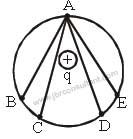
(a) least along the path AB
(b) least along the path AD
(c) zero along any one of the path AB, AC, AD and AE
(d) least along AE
Answer
C
Question 35. If a slab of insulating material 4 × 10–5 m thick is introduced between the plates of a parallel plate capacitor, the distance between the plates has to be increased by 3.5 × 10–5 m to restore the capacity to original value. Then the dielectric constant of the material of slab is
(a) 8
(b) 6
(c) 12
(d) 10
Answer
A
Question 36. A circuit is connected as shown in the figure with the switch S open. When the switch is closed, the total amount of charge that flows from Y to X is
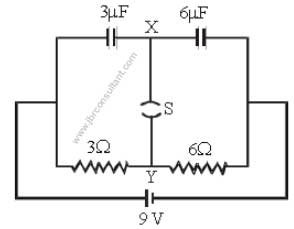
(a) 0
(b) 54 μC
(c) 27μC
(d) 81 μC
Answer
C
Question 37. A parallel plate capacitor of capacitance C is connected to a battery and is charged to a potential difference V. Another capacitor of capacitance 2C is similary charged to a potential difference 2V. The charging battery is now disconnected and the capacitors are connected in parallel to each other in such a way that the positive terminal of one is connected to the negative terminal of the other. The final energy of the configuration is
(a) Zero
(b) ![]()
(c) ![]()
(d) ![]()
Answer
B
Question 38. Three capacitors each of capacity 4mF are to be connected in such a way that the effective capacitance is 6 mF. This can be done by
(a) connecting two in parallel and one in series
(b) connecting all of them in series
(c) connecting them in parallel
(d) connecting two in series and one in parallel
Answer
D
Question 39. A network of four capacitors of capacity equal to C1 = C, C2 = 2C, C3 = 3C and C4 = 4C are conducted to a battery as shown in the figure. The ratio of the charges on C2 and C4 is

(a) 4/7
(b) 3/22
(c) 7/4
(d) 22/3
Answer
B
Question 40. A solid conducting sphere having a charge Q is surrounding by an uncharged concentric conducting hollow spherical shell. Let the potential difference between the surface of the solid sphere and that of the outer surface of the hollow shell be V. If the shell is now given a charge of – 3Q, the new potential difference between the same two surfaces is
(a) V
(b) 2 V
(c) 4 V
(d) – 2 V
Answer
A
Question 41. A capacitor of 4 μF is connected as shown in the circuit. The internal resistance of the battery is 0.5W. The amount of charge on the capacitor plates will be
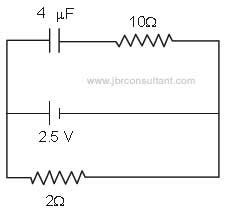
(a) 0 μC
(b) 4 μC
(c) 16 μC
(d) 8 μC
Answer
D
Question 42. A condenser of capacity C is charged to a potential difference of V1. The plates of the condenser are then connected to an ideal inductor of inductance L. The current through the inductor when the potential difference across the condenser reduces to V2 is
(a) 
(b) ![]()
(a) ![]()
(d) ![]()
Answer
A
Question 43. Equipotentials at a great distance from a collection of charges whose total sum is not zero are approximately
(a) spheres
(b) planes
(c) paraboloids
(d) ellipsoids
Answer
A
Question 44. The electrostatic potential on the surface of a charged conducting sphere is 100V. Two statements are made in this regard S1 at any point inside the sphere, electric intensity is zero. S2 at any point inside the sphere, the electrostatic potential is 100V. Which of the following is a correct statement?
(a) S1 is true but S2 is false
(b) Both S1 and S2 are false
(c) S1 is true, S2 is also true and S1 is the cause of S2
(d) S1 is true, S2 is also true but the statements are independant
Answer
C
Question 45. Two parallel plate capacitors of capacitances C and 2C are connected in parallel and charged to a potential difference V. The battery is then disconnected and the region between the plates of the capacitor C is completely filled with a material fo dielectric constant K. The potential difference across the capacitors now becomes
(a) 3v/ k + 2
(b) KV
(c) V/K
(d) 3KV
Answer
A
Question 46. Two vertical metallic plates carrying equal and opposite charges are kept parallel to each other like a parallel plate capacitor. A small spherical metallic ball is suspended by a long insulated thread such that it hangs freely in the centre of the two metallic plates. The ball, which is uncharged, is taken slowly towards the positively charged plate and is made to touch that plate. Then the ball will
(a) stick to the positively charged plate
(b) come back to its original position and will remain there
(c) oscillate between the two plates touching each plate in turn
(d) oscillate between the two plates without touch them
Answer
C
Question 47. The effective capacitance of combination of combination of equal capacitors between points A and B shown in figure is

(a) C
(b) 2C
(c) 3C
(d) C/2
Answer
B
Question 48. A parallel plate capacitor is connected to a battery. The quantities charge, voltage, electric field and energy associated with this capacitor are given by Q0, V0, E0, and U0 respectively. A dielectric slab is now introduced to fill the space between the plates with the battery still in connection. The corresponding quantities now given by Q, V, E and U are related to the previous ones as
(a) Q > Q0
(b) V > V0
(c) E > E0
(d) U < U0
Answer
A
Question 49. In the circuit given below, the charge in mC, on the capacitor having 5 μF is
(a) 4.5
(b) 9
(c) 7
(d) 15
Answer
B
Question 50. A parallel plate capacitor of plate area A and plate separation d is charged to potential difference V and then the battery is disconnected. A slab of dielectric constant K is then inserted between the plates of capacitor so as to fill the space between the plates. If Q, E and W denote respectively, the magnitude of charge on each plate electric field between the plates (after the slab is inserted), and work done on the system, in question, in the process of inserting the slab, then which is wrong ?
(a) Q=![]()
(b) Q=![]()
(c) E=![]()
(d) W=![]()
Answer
B
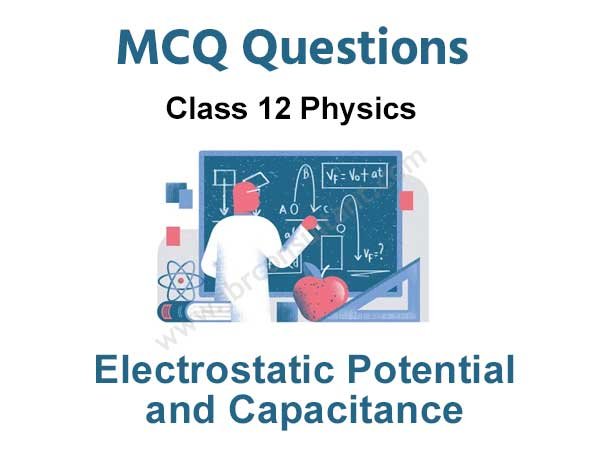
You can easily get good marks If you study with the help of Electrostatic Potential and Capacitance MCQ. We trust that information provided is useful for you. NCERT MCQ Questions for Class 12 Electrostatic Potential and Capacitance PDF Free Download would without a doubt create positive results.
We hope the information shared above in regards to Electrostatic Potential and Capacitance MCQ has been helpful to you. if you have any questions regarding CBSE Class 12 Physics Solutions MCQs Pdf, write a comment below and we will get back to you as soon as possible.
Frequently Asked Question (FAQs)
How many MCQ questions are there in CLass 12 chapter 2 Physics?
In Class 12 chapter 2 Physics, we have provided 50Can we score good marks in Class 12 Physics with the help of MCQ Questions?
Can we score good marks in Class 12 Physics with the help of Electrostatic Potential and Capacitance MCQ Questions?
Yes, MCQ Question is one of the best strategies to make your preparation better for the CBSE Board Exam. It also helps to know the student’s basic understanding of each chapter. So, You can score good marks in the Class 12 Physics exam.


